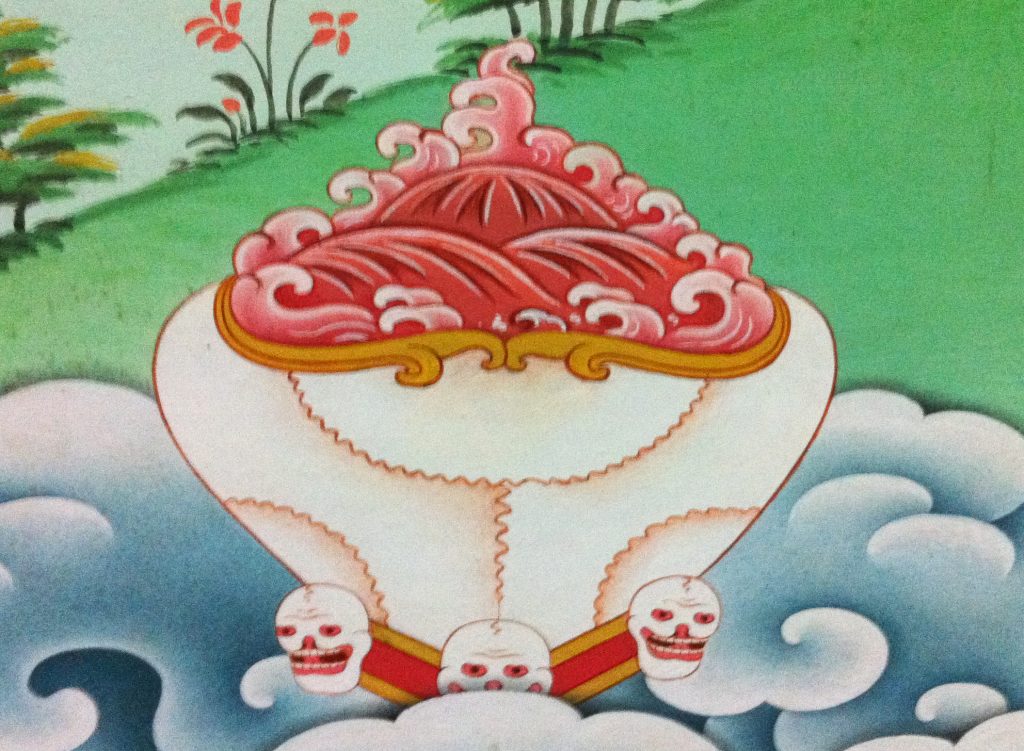According to tantra, the human body is perceived as a sacred temple in which all higher forces and the whole truth about existence are present. One of those truths, fundamental to Vajrayana Buddhism, is impermanence (Skt. anitya, Tib. mitagpa). The visual representation of the transience of the human body, and hence the Buddhist idea of impermanence, is found in the iconography of the skull cup (kapala, thopa), which is held in the left hand of dakinis or skydancers – female emanations of wisdom that assist us along the spiritual path. The skull cup is made from the crown of a human skull and serves as a ritual vessel of many other deities in the Vajrayana pantheon, like wrathful protectors, yidams, mahasiddhas and yogis. As a ritual vessel, kapala combines the symbolism of the clay pot of Vedic sacrifices (Skt. kumbha), the Lord Buddha’s begging bowl (Skt. patra), and the sacred vase of bodhisattvas (Skt. kalasha) (Robert Beer 1999: 263).
Different aspects of the nature of the dakini can be discovered in the symbolism of kapala. Their dynamic and vital character corresponds to the rhythmic movement of nature. Cyclical processes in nature express the natural course of life and human existence. Women are naturally inclined to feel more intimately the Earth’s cyclical patterns as they are compelled every month to rejuvenate their body through menstruation. Most religions identify woman during her monthly cycle as “ritually unclean” and during this period, all sacred activities are taboo for her.
The substances from her body during that time are also considered contaminated. Yet it is well known that tantric Buddhism deals with the transformation of “impure” into perfectly pure things through awareness of the inherently pure nature of all phenomena, the perception of which depends solely on the purity of consciousness. In turn, Vajrayana art interprets this idea in the details of dakini iconography, which applies the principle of tantra to perceive all aspects of life in a natural way.

The kapala in the hands of dakinis is sometimes described as full of menstrual blood. Blood is displayed bright red in color and boiling, which symbolically represents the warmth of the womb from where it originates. Quite often this cup is raised to the level of the mouth, with the intention to be drunk. If this fact is to be taken literally, it is indeed shocking, but if we seek its metaphorical sense, perhaps it would help to develop a deeper understanding of the lore of the kapala. Understanding such a gesture requires the clarification of the symbolism behind the term bodhichitta (Tib. jang chub sem). It represents one of the most important aspects of Mahayana and Vajrayana Buddhism—the aspiration to achieve enlightenment for the benefit of all sentient beings. In the higher teachings of tantric Buddhism, bodhichitta also means “inherent non-dual consciousness” in which male and female principles are represented as one.
The terms “male bodhicitta” and “female bodhichitta” represent their inseparable union. Red blood in the kapala is associated with “female bodhichitta”, while “male bodhichitta” is usually associated with semen. The “female bodhichitta” is located at the “secret place” below the navel, and the “male bodhichitta” at the crown of the head. According to tantric Buddhism, when the red “female bodhichitta” and the white “male bodhichitta” unite in the form of an indestructible drop (bindu, thigle). This state, characterized by the feeling of immense bliss, has the power to remove the bondages of cyclic existence.

The concept of merging the “male and female bodhichittas” as a precondition for achieving a higher state of consciousness and realization of the aspiration to achieve enlightenment is presented in Buddhist iconography by the symbolic image of the dakini’s ritual cup. Sometimes the liquid in the kapala is pink in color, which symbolizes the merging of the red and white color of both bodhichittas. This particular example is an illustration of a typical Vajrayana principle to display externally what has to be achieved internally in the process of spiritual practice.
So, the kapala with blood is a symbolic manifestation of the mystical mixture of male and female substances that become the elixir of immortality (amrita, dudtsi) or nectar of supreme bliss (maha sukha, dewa chenpo). Drinking that amrita symbolizes taking in liberation. Female images, holding a skull cup with blood ready to drink it, are striking examples of the deep symbolism of Buddhist tantric iconography.

